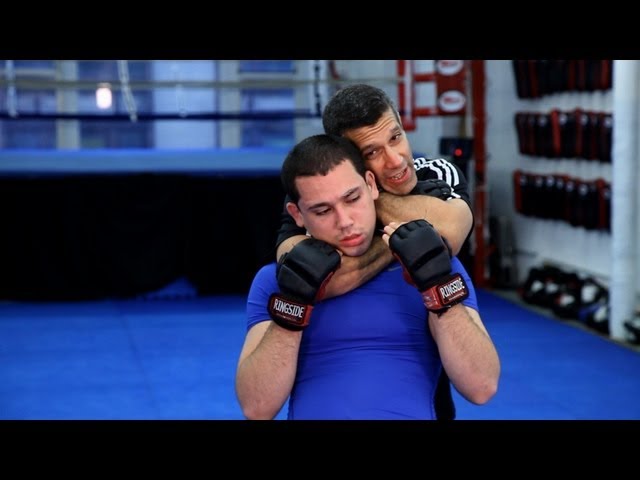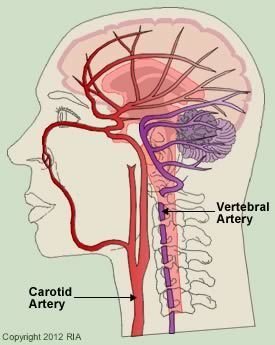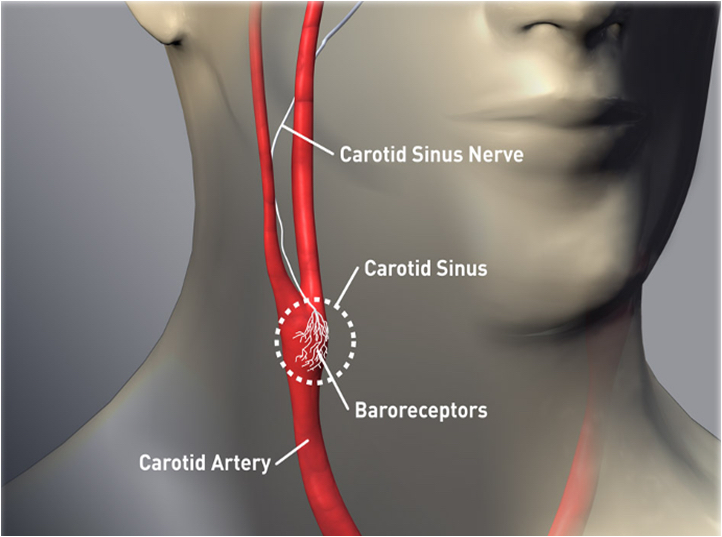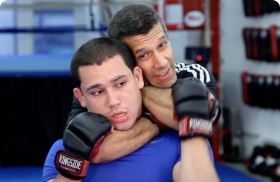In MMA the rear naked choke is the undisputed king of finishes.
According to statistics for every UFC match over the last 25 years, it accounts for nearly 40% of submission finishes and is the means of victory for 1 out of every 13 fights. While 1/13th may not seem so very high at first glance, it is important to note that no other single move from any martial art comes even close to that number.
But even though the RNC is ubiquitous in combat, there are some major misunderstanding and misconceptions about the technique that I would like to address.
Choke vs. Strangulation
First, let’s start with the most typical version of RNC, which is demonstrated below, and is known in Japanese Judo as a type of Hadake Jime 「裸締め」of which “Naked Choke” is a very poor translation.

It is unfortunate that this translation stuck as “naked” doesn’t mean you are naked when you do the move (let’s admit we have all seen untrained people’s perplexed expressions or smiles when we first say “rear naked” to them), rather it is supposed to convey the idea that you are not using an implement like clothing or a weapon to assist your technique. On top of that “choke” is actually completely incorrect as well.
Let’s clarify something: outside of martial arts, a choke specifically refers to an obstruction of the throat, trachea or larynx, as in “choking on a fish bone.”
Constriction of the throat or carotid arteries etc. is more correctly a strangulation, as in “the snake strangled its prey.”
The RNC is a strangulation not a choke.
However, because of the poor translation from a poor Japanese speaker done about 130 years ago, the two terms are often conflated, even by experts.
The Big Misconception
Now let’s get to an even bigger misconception: how the RNC actually works.
The RNC primarily attacks the two carotid arteries on the sides of the neck. when asked to explain the move, most Judo, BJJ or grappling practitioners will say that cutting off the blood flow from the carotids to the brain is the mechanism by which the RNC works.
But this is wrong!
Contrary to what most people believe, the carotid arteries are not the major suppliers of blood to the brain. Therefore, attacking them will not completely cut off circulation to the brain, merely restrict it.
The human neck has four major arteries that provide oxygen to the brain: two carotid arteries and two vertebral arteries (these run in tandem with the spinal column towards the rear of the neck).

Blood chokes like the RNC affect only the carotid arteries: they DO NOT affect the vertibral arteries. When applying a traditional RNC only a very small amount of blood flow (approximately 10%) is impeded.
So what actually makes an RNC work and so effective?
Actual RNC Mechanics
As I said above, most people, especially martial artists, incorrectly believe RNC induced unconsciousness is caused by hypoxia (lack of oxygen) due to lack of blood flow.
But as I have mentioned above, only 10% of the blood flow is stopped so this is can not be the case. Also hypoxia takes quite a long time, while any experienced grappler will know that RNCs can induce tap outs and unconsciousness very quickly.
So what is going on?
Running tandem to the carotids are clusters of nerves known as baroreceptors, which connect to the carotid sinus nerve.

During strangulations these receptors sense danger, incorrectly interpreting the force applied by the choke as a massive increase in blood pressure.
This is exacerbated by pressure on the jugular vein, which impairs blood outflow (known as “venous outflow obstruction”).
The body senses tremendous danger in this pressure. In order to counteract this, the body acts to relieve the perceived pressure by dilating the brain’s capillaries.
Since the victim’s actual blood pressure was not elevated, the individual passes out due to the sudden change in pressure. This is similar to how an individual with low blood pressure might faint from standing up too quickly.
So the activation of pressure on these receptors are the true mechanics of the RNC and explain clearly why victims of the technique lose consciousness so quickly.
Brain Damage & Death
That being said, consistent and intense pressure differentials are not optimal for brain health, and extended application of an RNC will absolutely result in hypoxic ischemic encephalopathy (HIE) a type of brain dysfunction that occurs when the brain doesn’t receive enough oxygen or blood flow.
Extended application of an RNC will eventually induce HIE, which will first cause tissue death (infarction) and then complete neuronal death (brain death). Unfortunately this has been a cause of death in both combat athletics as well as street violence.
Safety Concerns
Research has demonstrated that the carotid arteries may collapse under 5.5 to 22 pounds of pressure, while vertebral arteries can collapse under 18 to 66 pounds of pressure.
Expert practitioners of BJJ, through use the principles of leverage, have been known to generate in excess of 100–150 force-pounds when measured with devices shaped to simulate the human neck.
This is why it is always advisable to tap early.
These are very dangerous moves even in controlled environments. Any consistent compression of the carotid or vertibral blood systems is potentially injurious (and is unfortunately the subject of much discussion in law enforcement circles these days).
For my next post I will discuss so-called ”air chokes”
Reference:
- There is more to the mechanism of unconsciousness from vascular neck restraint than simply carotid compression, Samuel J Stellpflug et al. Int J Neurosci. 2020 Jan.
- Strangulation Injuries, Dunn RJ, Smock W, Carroll ME, et al.
- Partial List of Deaths Due to Chokes/Strangulations
